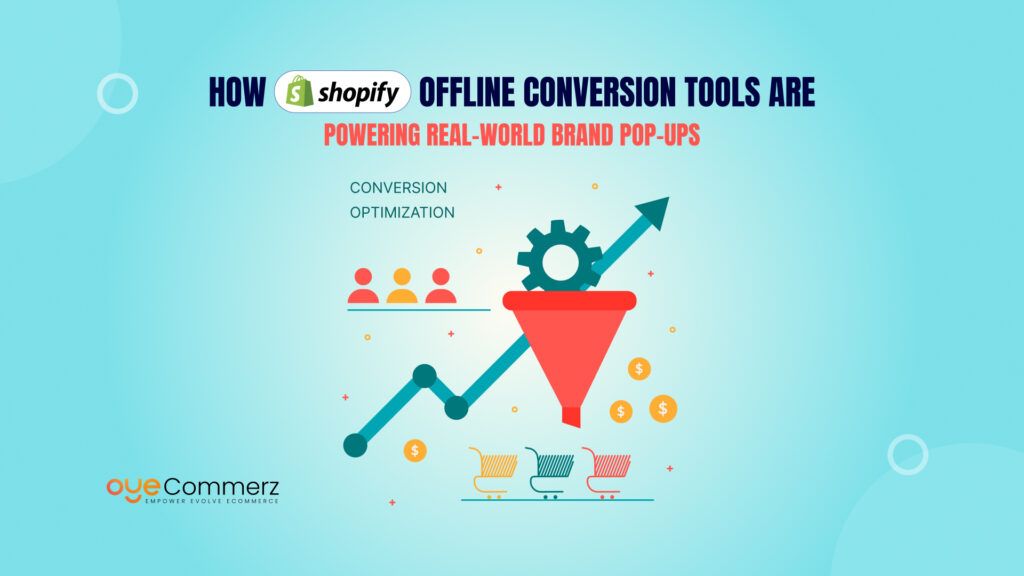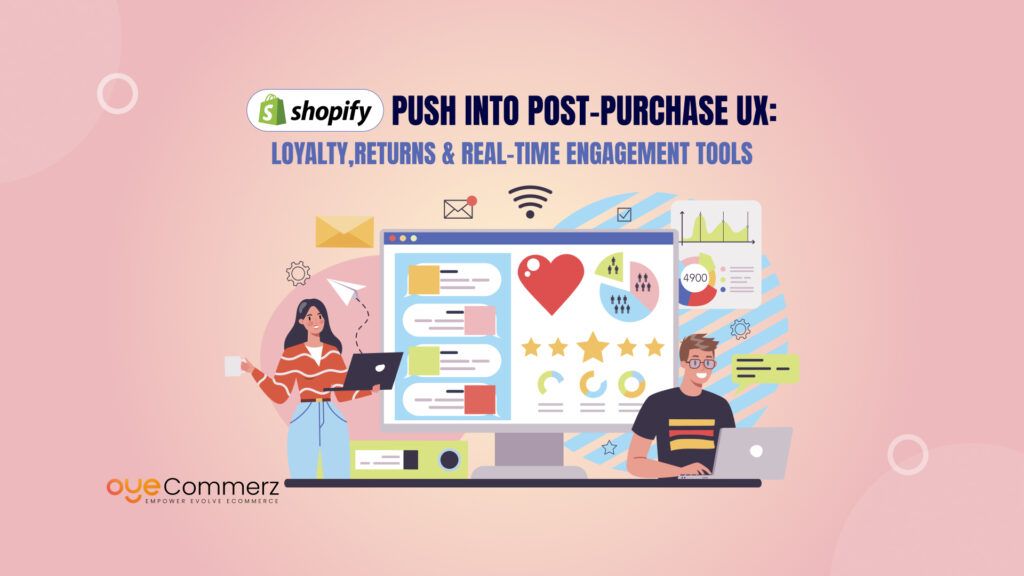Over 90% of people trust recommendations from individuals over brands. That’s why influencer marketing and referral programs have become essential for eCommerce growth.
But here’s the catch: if you can’t accurately track referrals, you can’t reward the right influencers or measure what’s working.
Shopify has been a key player in helping brands run influencer campaigns, but traditional tracking methods like discount codes and cookies are no longer enough.
Now, with updates like Shopify Collabs, server-side tracking, and smarter affiliate apps, referral tracking is evolving fast and it’s changing how brands run and scale influencer campaigns.
Let’s explore what’s new and why it matters.
Table of Contents
ToggleThe Old Way: Traditional Referral Tracking on Shopify
In the early days of influencer marketing on Shopify, tracking referrals was mostly done using manual methods like discount codes and UTM links. Brands would assign unique codes to influencers or track link clicks in Google Analytics.
While simple to set up, these methods came with serious limitations:
- Cookie-based tracking often broke across devices or browsers
- UTM links didn’t always tie back to final sales
- Attribution gaps made it hard to know who truly drove a purchase
- Brands had to rely on influencer honesty or guesswork when measuring results
Worse yet, multi-touch attribution when a customer interacts with several channels before buying was rarely accounted for. And with data often lost between mobile and desktop, brands couldn’t see the full picture.
In short, the old way worked until it didn’t.
The Shift: How Referral Tracking on Shopify Is Evolving
 With digital privacy changes, cross-device shopping, and rising influencer collaborations, Shopify is evolving its approach to referral tracking moving beyond basic discount codes and cookies toward a more sophisticated, accurate, and integrated system.
With digital privacy changes, cross-device shopping, and rising influencer collaborations, Shopify is evolving its approach to referral tracking moving beyond basic discount codes and cookies toward a more sophisticated, accurate, and integrated system.
Let’s break down the key changes transforming how referral tracking works on Shopify:
1. Shopify Collabs: Built-In Influencer Management
One of the biggest game changers is Shopify Collabs Shopify’s official tool designed to help merchants discover, manage, and reward influencers.
With Collabs, brands can:
- Find relevant creators through a searchable network
- Invite them to promote products with affiliate links or discount codes
- Automatically track referrals and reward commissions
- Send products and manage gifting campaigns in one dashboard
This streamlines what used to be a fragmented process and ensures referrals are tracked more reliably from the moment an influencer joins the campaign.
2. First-Party Data Tracking: Solving Privacy Challenges
Third-party cookies are becoming obsolete thanks to updates like Apple’s iOS 14+ privacy rules and growing global data regulations (like GDPR and CCPA). As a result, Shopify and its partner apps are moving toward first-party data tracking.
This means:
- Data is collected directly from your store (not external scripts)
- Tracking works more reliably across browsers and devices
- You remain compliant with privacy laws while keeping attribution data intact
It’s a win-win: better performance for marketers, more protection for customers.
3. Server-Side Tracking and APIs: Better Attribution Accuracy
Traditional browser-based tracking is prone to data loss. With server-side tracking, Shopify and affiliate apps now send event data (like clicks, add-to-carts, and purchases) directly from the server.
This ensures:
- More accurate tracking, especially across devices
- Less risk of data being blocked by ad blockers or browser settings
- Better attribution for complex customer journeys
Additionally, public APIs allow brands to create custom integrations with CRMs, influencer tools, and analytics platforms making tracking more tailored and robust.
4. Smarter Affiliate Apps: Real-Time Dashboards and Deeper Insights
Apps like Refersion, UpPromote, and Snowball are now much more advanced than before. They offer:
- Real-time referral dashboards for both brands and influencers
- Automated tracking of clicks, conversions, and payouts
- Tiered commission structures and campaign segmentation
- Fraud detection and performance benchmarking
These tools take the guesswork out of influencer campaigns by giving both parties clear insights into what’s working and what’s not.
5. CRM & Email Marketing Integration: Full-Funnel Visibility
Referral tracking no longer ends at the sale. With integrations into platforms like Klaviyo, HubSpot, and Omnisend, brands can now:
- See how referred traffic moves through the email journey
- Retarget referred users with personalized content
- Track long-term customer value, not just the first sale
This full-funnel view helps brands better understand the lifetime impact of influencer driven traffic, not just the initial conversion.
What This All Means
Together, these changes represent a significant upgrade in how Shopify brands can manage and scale influencer campaigns. Tracking is no longer just about clicks and codes, it’s about building a transparent, data-rich partnership between brands and creators.
For brands, this means smarter decisions and better ROI. For influencers, it means fairer payouts and real-time performance feedback.
Why It Matters for Influencer Campaigns
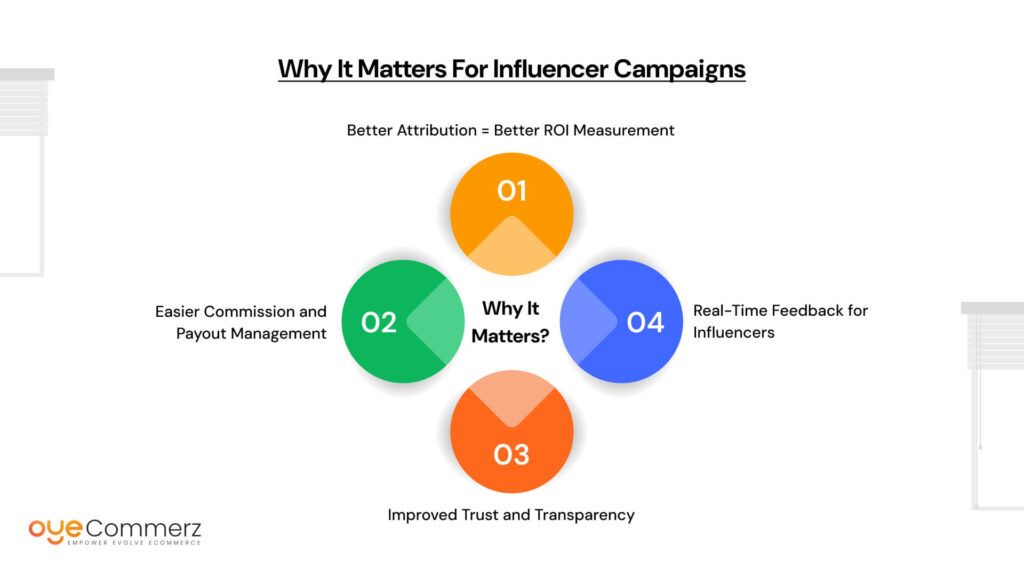
The evolution of referral tracking on Shopify isn’t just a technical upgrade; it has a direct impact on how influencer campaigns are planned, executed, and optimized. Here’s why these changes matter so much for both brands and creators:
1. Better Attribution = Better ROI Measurement
With advanced tracking tools and first-party data, brands can now accurately attribute sales to specific influencers. This means no more guessing which creator drove which sale, and no more over-crediting one channel over another.
Clear attribution helps marketers:
- Identify top-performing influencers
- Double down on the channels that convert
- Justify campaign spend with hard data
For influencers, this ensures fair recognition and compensation for the traffic and revenue they generate.
2. Easier Commission and Payout Management
In the past, paying influencers required spreadsheets, manual tracking, and trust. With new tools like Shopify Collabs and affiliate apps, commissions can now be:
- Automatically calculated based on actual sales
- Paid out on a scheduled basis
- Tracked by both the brand and the influencer in real time
This saves time, reduces errors, and simplifies scaling influencer programs even across dozens or hundreds of partners.
3. Improved Trust and Transparency
When tracking is unclear or inconsistent, it can create tension between brands and influencers. Did that sale come from the influencer? Was it counted correctly? Why wasn’t the commission paid?
With today’s tools, everything is transparent:
- Influencers can see clicks, conversions, and earnings live
- Brands can monitor campaign performance and verify results
- Disputes over tracking and payment are reduced significantly
This builds mutual trust, which is essential for long-term partnerships.
4. Real-Time Feedback for Influencers
Influencers no longer have to wait weeks for vague campaign reports. With modern dashboards and live tracking, they can:
- Instantly see how their content is performing
- Adjust messaging or timing to improve results
- Optimize their strategy in real time
This feedback loop empowers influencers to perform better, making them more effective and engaged partners.
Challenges and Considerations
While Shopify’s evolving referral tracking tools offer major advantages, they’re not without challenges. For brands and influencers alike, adopting new systems requires careful planning, legal awareness, and ongoing education. Here are the main hurdles to keep in mind:
1. Data Privacy Laws Are Changing the Rules
With regulations like GDPR (EU), CCPA (California), and others around the world, businesses must be more cautious about how they track and store user data.
These laws:
- Limit the use of third-party cookies
- Require user consent for tracking
- Enforce data transparency and control for consumers
Shopify and app developers are adapting by relying on first-party tracking and privacy-compliant practices, but brands must still ensure their campaigns and tools follow the latest guidelines. Failing to do so can lead to legal risks and loss of customer trust.
2. Integration Complexities Across Multiple Tools
Many brands use a mix of platforms Shopify, Klaviyo, influencer apps, CRMs, analytics tools, and more. Integrating all of these for seamless referral tracking can be:
- Technically demanding
- Time-consuming
- Prone to errors if not set up correctly
Even with modern APIs and automation, setting up a well-integrated tech stack often requires developer support or expert guidance, especially for growing businesses.
3. Steep Learning Curve for Small Businesses
For solopreneurs or small brands, the shift from basic tracking methods (like discount codes) to advanced referral systems can be overwhelming.
They may struggle with:
- Understanding how new tracking models work
- Choosing the right affiliate platform
- Interpreting performance metrics and reports
Without the resources of larger marketing teams, there’s a real risk of underutilizing the tools or avoiding them altogether.
4. Influencer Skepticism and Onboarding Challenges
While new tracking tools benefit influencers in the long run, not all creators are quick to adopt unfamiliar platforms. Some may be skeptical about:
- How their data is used
- Whether commissions are tracked fairly
- Learning new dashboards or systems
This makes education and onboarding essential. Brands must take the time to explain how the tools work, ensure influencers feel comfortable, and offer support throughout the campaign.
Best Practices for Brands Using Referral Tracking on Shopify
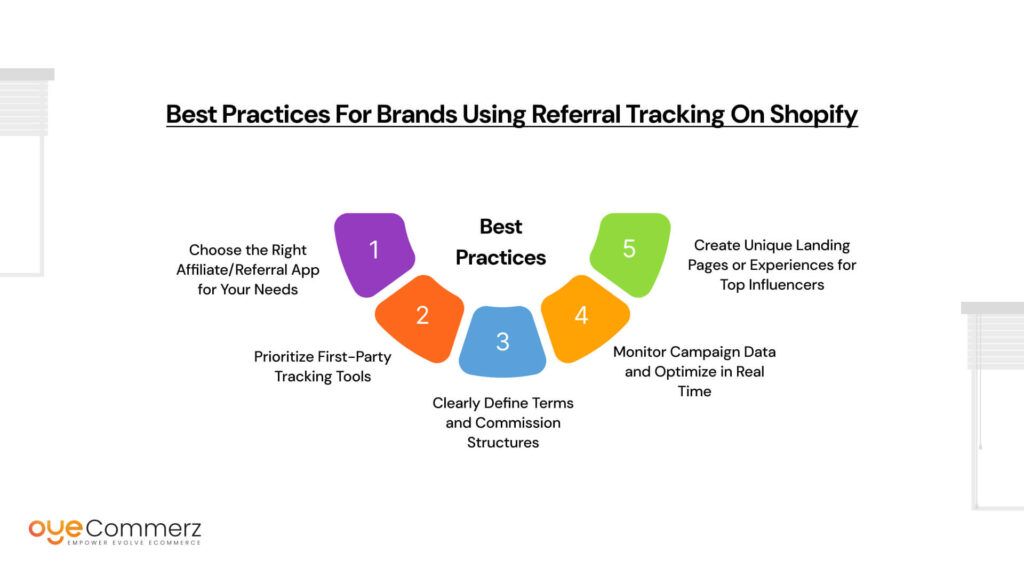
Adopting modern referral tracking tools is only the first step. To truly succeed with influencer campaigns on Shopify, brands need to implement strategies that maximize accuracy, performance, and collaboration. Here are five proven best practices:
1. Choose the Right Affiliate/Referral App for Your Needs
Not all affiliate tools are built the same. Choose a platform that aligns with your business size, technical capacity, and campaign goals.
- For small to mid-sized stores: Tools like UpPromote or Snowball offer plug-and-play setups with intuitive dashboards.
- For larger or more complex needs: Apps like Refersion or LeadDyno provide deeper analytics, API support, and scalability.
- Built-in Shopify option: Shopify Collabs is a great starting point for brands that want an integrated influencer management system.
Take time to compare features, support, and pricing before committing.
2. Prioritize First-Party Tracking Tools
To stay ahead of data privacy regulations and avoid attribution gaps, make sure the tools you use rely on first-party tracking rather than third-party cookies.
Look for apps that:
- Work natively with Shopify’s checkout and customer data
- Use pixel-less or server-side tracking
- Are transparent about how they collect and process user data
This ensures more reliable attribution while remaining compliant with laws like GDPR and CCPA.
3. Clearly Define Terms and Commission Structures
A successful referral program starts with clear expectations. Make sure influencers understand:
- How and when they’ll be paid
- What counts as a valid conversion or referral
- Any exclusions (e.g., discounted products, self-referrals)
Put these terms in writing ideally in a digital agreement and make sure they match what your affiliate platform enforces automatically. Transparency leads to stronger relationships and fewer disputes.
4. Monitor Campaign Data and Optimize in Real Time
Modern tools allow you to see performance metrics like:
- Click-through rates
- Sales generated by each influencer
- Customer lifetime value from referred traffic
Use this data to optimize on the fly whether that means increasing commissions for high performers, providing better creatives, or pausing underperforming partnerships.
Don’t just “set and forget.” Continuous refinement is key to maximizing ROI.
5. Create Unique Landing Pages or Experiences for Top Influencers
Take your influencer campaigns a step further by building personalized landing pages or curated product collections for top partners.
Benefits include:
- Higher conversion rates from relevant messaging
- Stronger brand-influencer alignment
- Easier performance tracking tied to specific pages
Tools like PageFly or Shogun (alongside Shopify’s native features) make it easy to create customized experiences that resonate with each influencer’s audience.
By following these best practices, you’ll be well-positioned to run influencer campaigns that are more accurate, scalable, and rewarding for both your brand and your creators.
The Future: Where Referral Tracking and Influencer Marketing Are Heading
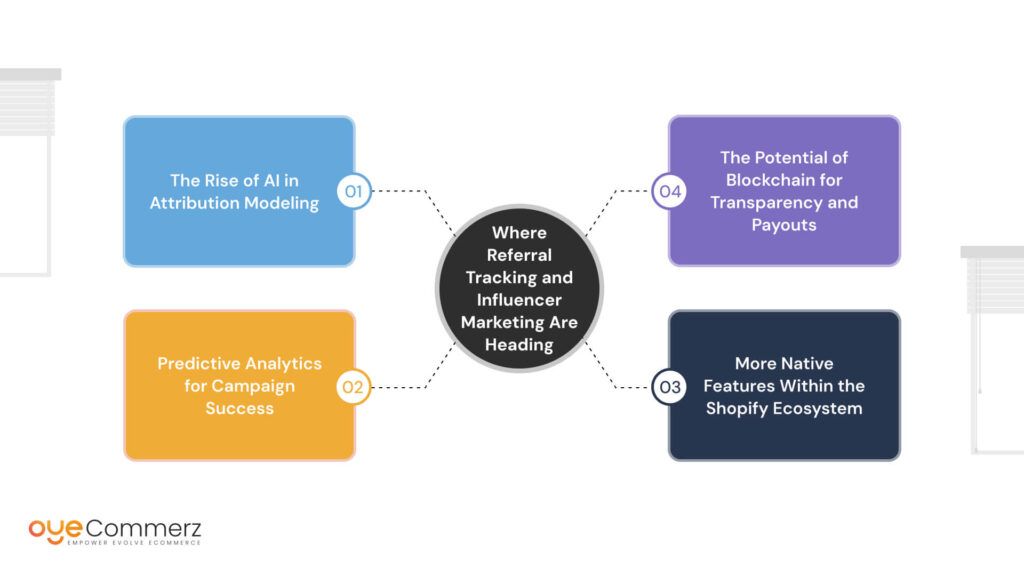
As referral tracking continues to evolve, Shopify and its ecosystem are heading toward a smarter, more predictive, and transparent future. Here are four major trends shaping what’s next for influencer campaigns:
1. The Rise of AI in Attribution Modeling
Traditional attribution models often struggle to account for multi-touch customer journeys. Enter AI-powered attribution, which can:
- Analyze millions of data points across channels
- Identify patterns in how customers interact with influencers, ads, and content
- Assign credit more fairly based on true influence, not just last-click
In the Shopify ecosystem, future tools may leverage AI to automatically suggest which influencers drive not just clicks but actual purchases and long-term customer value.
2. Predictive Analytics for Campaign Success
With enough data, platforms are beginning to predict which influencer campaigns are likely to succeed before they even launch. Soon, Shopify brands may be able to:
- Forecast ROI based on historical campaign data
- Identify influencer profiles that match their best customers
- Set real-time benchmarks and alerts during active campaigns
This allows brands to allocate budget more strategically and make faster, smarter decisions especially during key sales periods.
3. More Native Features Within the Shopify Ecosystem
As Shopify continues investing in influencer and affiliate capabilities, we can expect to see more built-in features such as:
- Deeper integration between Shopify Collabs, Shopify Flow, and Shopify Email
- Native reporting dashboards showing referral funnel performance
- Automated influencer onboarding and product seeding tools
- Unified profiles for influencers with sales history and rankings
These features will likely reduce the need for third-party apps while making it easier for smaller brands to launch influencer programs with minimal setup.
4. The Potential of Blockchain for Transparency and Payouts
While still early, blockchain technology could revolutionize referral tracking by offering:
- Tamper-proof, transparent records of referrals and conversions
- Smart contracts for automated, trustless commission payouts
- Proof-of-influence systems that validate authentic engagement
This could solve long-standing trust issues between brands and influencers especially around attribution and payment and make the system more equitable and accountable.
Looking Ahead
The future of referral tracking on Shopify is moving toward automation, intelligence, and transparency. Brands that embrace these innovations will gain a competitive edge in the crowded world of influencer marketing.
It’s not just about tracking better it’s about building smarter partnerships, predicting success, and scaling authentically in a privacy-conscious world.
Supercharge Your Influencer Marketing on Shopify
Looking to streamline your influencer campaigns on Shopify?
Oyecommerz helps eCommerce brands integrate cutting-edge referral tracking tools and run high-converting influencer campaigns with ease.
Whether you’re starting from scratch or optimizing an existing strategy, we’ll make sure your tracking is accurate, scalable, and built for growth.
Contact to Migrate your Site to Shopify Now
Conclusion
Shopify’s referral tracking is rapidly evolving from basic coupon codes and cookies to advanced systems powered by first-party data, server-side tracking, and built-in tools like Shopify Collabs. This shift is helping brands and influencers measure performance more accurately, manage payouts efficiently, and build trust through real-time insights. While privacy laws, tool integration, and education pose some challenges, the benefits of smarter tracking far outweigh the hurdles. For eCommerce brands looking to scale influencer marketing, now is the ideal time to modernize your referral strategy and stay competitive in a data-driven, privacy-conscious market.
Frequently Asked Questions
To keep track of a referral program, you need a reliable system that records who referred whom, tracks the sales or actions generated from referrals, and calculates rewards or commissions. This is usually done using affiliate or referral marketing software that integrates with your store. Key tracking methods include unique referral codes, custom URLs with UTM parameters, and cookies or first-party tracking pixels. Regular monitoring and reporting help you measure performance and optimize your program.
Shopify itself doesn’t run a universal referral program for merchants, but it offers tools and apps to help store owners create their own referral or affiliate programs. Shopify’s Shopify Collabs app, for example, is designed for influencer and affiliate marketing, helping merchants manage referrals, track influencer sales, and pay commissions—all within Shopify’s ecosystem.
To set up tracking on Shopify, you can:
Use built-in tools like Shopify Collabs for influencer/referral tracking.
Install referral or affiliate apps such as Refersion, UpPromote, or ReferralCandy.
Create unique discount/referral codes for influencers or customers.
Use UTM parameters in URLs to track traffic sources via Google Analytics.
Enable conversion tracking pixels (like Facebook Pixel or Google Tag Manager) to capture referral-driven sales.
Configure server-side tracking or webhook integrations for more advanced attribution.
Referral codes are tracked by assigning a unique code to each referrer (influencer, affiliate, or customer). When someone uses that code at checkout, Shopify records the order with the code attached. Using Shopify’s reporting or an affiliate app dashboard, you can see how many sales or signups came from each code. Many apps automate commission calculations and payouts based on referral code usage, ensuring accurate and transparent tracking.


